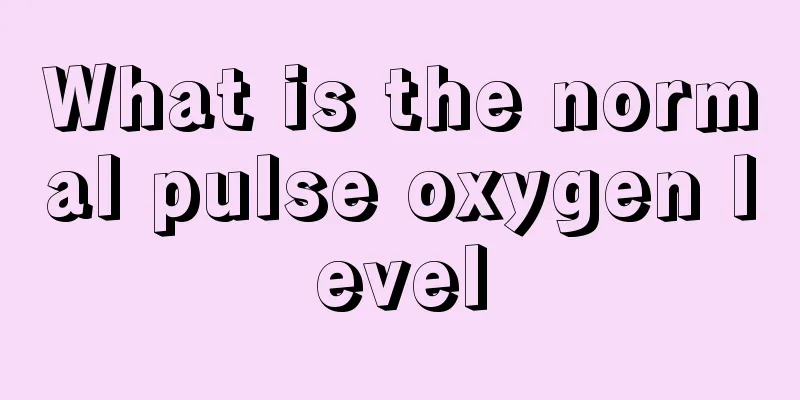What is the normal pulse oxygen level

|
People cannot survive without oxygen, so after the human body absorbs oxygen, it will be transmitted to various parts of the body through the blood, thereby increasing the oxygen content in the human blood. Generally speaking, the higher the oxygen content, the stronger the body's digestion and absorption function will be, and the stronger its metabolic capacity will be. The oxygen level in your blood can be measured using a pulse oximeter. So, what is a normal pulse oximeter? Humans rely on oxygen to survive. After oxygen is inhaled from the lungs, it enters the blood through the capillaries and is transported by the blood to various organs or cells in the body for use. The higher the oxygen content in the blood, the better the person's metabolism. Of course, high blood oxygen content is not a good thing. The blood oxygen in the human body has a certain saturation. Too low will cause insufficient oxygen supply to the body, and too high will cause aging of cells in the body. Both O2 and CO2 exist in the blood in two forms: physically dissolved and chemically bound. Gas and hemoglobin exist in the form of complexes. If the oxygen concentration is high, hemoglobin will complex with oxygen. If the carbon dioxide concentration is high, hemoglobin will complex with carbon dioxide. In the body's arterial blood, the oxygen concentration is high, and in the body's venous blood, the carbon dioxide concentration is high. Oxygen partial pressure (PO2) refers to the tension generated by oxygen molecules physically dissolved in plasma (so it is also called oxygen tension). In 100 ml of blood at 37°C, oxygen dissolved in a physical state can produce an oxygen partial pressure of 0.133 kPa (1 mmHg) for every 0.003 ml. When a normal person is at rest and breathes sea level air, the oxygen physically dissolved in the arterial blood is about 0.3 ml%, the partial pressure of oxygen in the arterial blood (PaO2) is about 13.3 kPa (100 mmHg); the normal partial pressure of oxygen in the venous blood (PvO2) is about 5.32 kPa (40 mmHg). PaO2 mainly depends on the level of alveolar oxygen partial pressure (PAO2), the amount of oxygen diffused into the blood through the alveolar membrane, and the ratio of alveolar ventilation to pulmonary blood flow. If the oxygen partial pressure of the outside air is low or alveolar ventilation is reduced, the alveolar oxygen partial pressure will decrease; or if diffusion disorder or ventilation/blood flow imbalance causes an increase in the functional or anatomical shunt of pulmonary arteriovenous blood, PaO2 may decrease. Oxygen content refers to the number of milliliters of oxygen contained in 100 milliliters of blood, including the oxygen actually bound to hemoglobin and the oxygen dissolved in plasma. Normal arterial blood oxygen content is about 19.3 ml%, and mixed venous blood oxygen content is about 12 ml%. The oxygen content in the blood mainly depends on PaO2 and the quality and quantity of hemoglobin. A significant decrease in PaO2 or a decrease in the ability of hemoglobin to bind oxygen, which reduces hemoglobin saturation, or a decrease in the amount of hemoglobin per unit volume of blood, can all reduce the oxygen content. The oxygen content depends on the amount of hemoglobin in a unit volume of blood and its ability to bind oxygen. If the hemoglobin content decreases (anemia) or the ability of hemoglobin to bind oxygen decreases (such as methemoglobin, carboxyhemoglobin), the oxygen capacity decreases and the oxygen content also decreases. If the amount and properties of hemoglobin per unit volume of blood are normal, the oxygen saturation of hemoglobin will decrease only due to the decrease in oxygen partial pressure. At this time, the oxygen content is reduced, but the oxygen capacity is normal. Oxygen capacity refers to the amount of oxygen bound to hemoglobin in 100 ml of blood in vitro when the oxygen partial pressure is 19.95 kPa (150 mmHg), the carbon dioxide partial pressure is 5.32 kPa (40 mmHg), and the humidity is 38°C. Under the above conditions, normal hemoglobin can bind 1.34 to 1.36 ml of oxygen per gram. If calculated based on 15 grams of hemoglobin per 100 ml of blood, the oxygen capacity of arterial and venous blood is approximately 20 ml%. Oxygen saturation refers to the percentage of hemoglobin that is saturated with oxygen. One gram of hemoglobin can combine with a maximum of 1.36 milliliters of oxygen, and the oxygen saturation reaches 100%. Oxygen saturation can be expressed by the following formula: Oxygen saturation (%) = actual oxygen bound to 1 gram of hemoglobin (ml) / 1.36 (ml) × 100 Normal arterial oxygen saturation is about 95-97%, and mixed venous oxygen saturation is about 75%. |
<<: What is a normal pulse rate for young people
>>: Where should I massage the soles of my feet if I have a bad stomach?
Recommend
Can taking a bath frequently remove moisture?
Everyone has some moisture in their body to a gre...
Why does my scalp hurt when I press it? What's wrong with my scalp?
In daily life, we often ignore some minor symptom...
How to store sweet potatoes for a year
Sweet potato is a kind of food that many people l...
What are the symptoms of kidney yin deficiency and hyperactivity of fire?
If there is excessive internal heat in the human ...
The harm of nose bridge corrector
People think that if their nose bridge can be hig...
Is prostate cancer related to genetics?
For prostate cancer, the growing cancer cells wil...
Advanced prostate cancer survival period
In 2012, the incidence of prostate cancer in my c...
What should you pay attention to when getting eyebrow tattoos
Eyebrow tattooing is something that requires spec...
There are some tips for the elderly to prevent tongue cancer
In recent years, the number of elderly people suf...
Can surgery be performed on brainstem hemorrhage
Brainstem hemorrhage can be said to be a very ser...
How to use brassinolide
Many people like to keep some green potted plants...
How to get foreign matter out of your eyes? Here are some tips to help you solve it
The beginning of spring has just passed, and the ...
How to generally care for fibroids
In life, many friends will grow some fibroids in ...
What to do if there is a cavity in the front tooth
Teeth are one of the features of a person's f...
How to quickly increase platelets
As we all know, platelets play a key role in the ...









